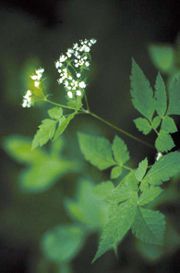Osmorhiza: Difference between revisions
Redirecting to Orris Root |
No edit summary |
||
| (3 intermediate revisions by 3 users not shown) | |||
| Line 1: | Line 1: | ||
{{SPlantbox | |||
|familia=Apiaceae | |||
|genus=Osmorhiza | |||
|taxo_author=Raf. | |||
|common_name=Sweet Cicely | |||
|Temp Metric=°F | |||
|jumpin=If this plant info box on watering; zones; height; etc. is mostly empty you can click on the edit tab and fill in the blanks! | |||
|image=Osmoriza claytonii.jpg | |||
|image_width=180 | |||
}} | |||
'''''Osmorhiza''''' is a genus of [[North America]]n [[perennial plant|perennial]] herbs, known generally as '''Sweet Cicely''' or '''Sweetroot'''. ''Osmorhiza longistylis'' was used by Native Americans to treat digestive disorders and as a wash for wounds. | |||
The [[seeds]] of this plant have barbs on the end allowing them to stick to clothing, fur, or feathers. | |||
{{Inc| | |||
Osmorhiza (Greek; referring to the sweet, aromatic, edible roots). Umbelliferae. A small genus of native herbs, 1 to 3 feet high, sometimes called sweet cicely, but the true sweet cicely is Myrrhis odorata, a closely allied European plant, the leaves of which have the scent of anise seed and are used in flavoring. Sometimes listed by dealers in native plants. | |||
Perennial, slender, hirsute or glabrous, with thin soft foliage: Lvs. ternately compound, the lfts. ovate and toothed: fls. very small, white, in small few-rayed umbels; calyx-teeth obsolete: fr. linear, glabrous or bristly; carpel slightly flattened dorsally or not at all; styles long or short; seed-face from slightly concave to deeply sulcate: root thick, aromatic. By some botanists, the name Washingtonia is used for this genus. The plants thrive in moist more or less shady woodsy places. | |||
}} | |||
==Cultivation== | |||
===Propagation=== | |||
===Pests and diseases=== | |||
==Species== | |||
*''[[Osmorhiza aristata|O. aristata]]'' | |||
*''[[Osmorhiza berteroi|O. berteroi]]'' (Tapering Sweetroot, Mountain Sweet Cicely) | |||
*''[[Osmorhiza brachypoda|O. brachypoda]]'' (California Sweet Cicely) | |||
*''[[Osmorhiza claytonii|O. claytonii]]'' (Clayton's Sweetroot, Sweet Cicely) | |||
*''[[Osmorhiza depauperata|O. depauperata]]'' (Bluntseed Sweetroot) | |||
*''[[Osmorhiza glabrata|O. glabrata]]'' | |||
*''[[Osmorhiza longistylis|O. longistylis]]'' (American Sweet Cicely, Sweet Cicely, White Cicely, Longstyle Sweetroot, Aniseroot, Licorice Root, or Wild Anise) | |||
*''[[Osmorhiza mexicana|O. mexicana]]'' (Mexican Sweet Cicely) | |||
*''[[Osmorhiza occidentalis|O. occidentalis]]'' (Western Sweetroot) | |||
*''[[Osmorhiza purpurea|O. purpurea]]'' (Purple Sweetroot) | |||
==Gallery== | |||
<gallery perrow=5> | |||
Image:Upload.png| photo 1 | |||
Image:Upload.png| photo 2 | |||
Image:Upload.png| photo 3 | |||
</gallery> | |||
==References== | |||
<references/> | |||
*[[Standard Cyclopedia of Horticulture]], by L. H. Bailey, MacMillan Co., 1963 | |||
<!--- xxxxx *Flora: The Gardener's Bible, by Sean Hogan. Global Book Publishing, 2003. ISBN 0881925381 --> | |||
<!--- xxxxx *American Horticultural Society: A-Z Encyclopedia of Garden Plants, by Christopher Brickell, Judith D. Zuk. 1996. ISBN 0789419432 --> | |||
<!--- xxxxx *Sunset National Garden Book. Sunset Books, Inc., 1997. ISBN 0376038608 --> | |||
==External links== | |||
*{{wplink}} | |||
{{stub}} | |||
__NOTOC__ | |||
Latest revision as of 22:06, 25 February 2010
| Osmorhiza subsp. var. | Sweet Cicely | |||||||||||||||||||||||||||||||||||||||||||||||||||||||
|---|---|---|---|---|---|---|---|---|---|---|---|---|---|---|---|---|---|---|---|---|---|---|---|---|---|---|---|---|---|---|---|---|---|---|---|---|---|---|---|---|---|---|---|---|---|---|---|---|---|---|---|---|---|---|---|---|

|
|
| ||||||||||||||||||||||||||||||||||||||||||||||||||||||
| ||||||||||||||||||||||||||||||||||||||||||||||||||||||||
Osmorhiza is a genus of North American perennial herbs, known generally as Sweet Cicely or Sweetroot. Osmorhiza longistylis was used by Native Americans to treat digestive disorders and as a wash for wounds.
The seeds of this plant have barbs on the end allowing them to stick to clothing, fur, or feathers.
| Standard Cyclopedia of Horticulture |
|---|
|
Osmorhiza (Greek; referring to the sweet, aromatic, edible roots). Umbelliferae. A small genus of native herbs, 1 to 3 feet high, sometimes called sweet cicely, but the true sweet cicely is Myrrhis odorata, a closely allied European plant, the leaves of which have the scent of anise seed and are used in flavoring. Sometimes listed by dealers in native plants. Perennial, slender, hirsute or glabrous, with thin soft foliage: Lvs. ternately compound, the lfts. ovate and toothed: fls. very small, white, in small few-rayed umbels; calyx-teeth obsolete: fr. linear, glabrous or bristly; carpel slightly flattened dorsally or not at all; styles long or short; seed-face from slightly concave to deeply sulcate: root thick, aromatic. By some botanists, the name Washingtonia is used for this genus. The plants thrive in moist more or less shady woodsy places.
|
Cultivation
Propagation
Pests and diseases
Species
- O. aristata
- O. berteroi (Tapering Sweetroot, Mountain Sweet Cicely)
- O. brachypoda (California Sweet Cicely)
- O. claytonii (Clayton's Sweetroot, Sweet Cicely)
- O. depauperata (Bluntseed Sweetroot)
- O. glabrata
- O. longistylis (American Sweet Cicely, Sweet Cicely, White Cicely, Longstyle Sweetroot, Aniseroot, Licorice Root, or Wild Anise)
- O. mexicana (Mexican Sweet Cicely)
- O. occidentalis (Western Sweetroot)
- O. purpurea (Purple Sweetroot)
Gallery
-
photo 1
-
photo 2
-
photo 3
References
- Standard Cyclopedia of Horticulture, by L. H. Bailey, MacMillan Co., 1963
External links
- w:Osmorhiza. Some of the material on this page may be from Wikipedia, under the Creative Commons license.
- Osmorhiza QR Code (Size 50, 100, 200, 500)
